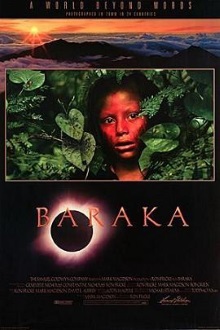Browsing the Lowyat forums for opinions about cinema is usually like diving into a cesspit but this one was an interesting suggestion that I believe I first saw there. Completely by coincidence, it also shares a similarity with the other film we watched this week: like The Hateful Eight, Baraka was filmed in a 70 mm format though this one used the even rarer and now defunct Todd-AO system. This film fully justifies the expansive format though as it is a documentary with absolutely no narration and no dialogue. Everything therefore rests solely on the power of its visuals and the brilliance of its musical accompaniment.
Without so such as any captions or intertitles, it’s hard to delineate Baraka into discrete parts, but nevertheless it is possible to discern that scenes are grouped into specific themes. As expected, breathtaking shots of natural scenery recur throughout the film and they are often bracketed by scenes of religious ceremonies to prompt a meditative attitude in the audience. From there it feels natural to move on to shots of tribal dances and celebrations including extended footage of a very striking performance of what seems to be the kecak in Bali, Indonesia. Some of my favorite sequences however are when the focus moves to the cities, covering both the mass movement of humanity and the vast scales of human industry. There’s a subtle sense of humor at play when time-lapse shoots of large numbers of people milling about subway stations and large street junctions are intercut with seemingly endless streams of yellow chicks being transported every which way on conveyor belts.
With a running time of nearly an hour and forty minutes, I worried that an endless succession of pretty scenery, however beautifully shot, would eventually grow tiresome. Fortunately director and photographer Ron Fricke is excellent at managing the pace, switching up shots and using music to keep the audience’s interest level high. He is especially good at ensuring that there’s always a human link in every scene by showing portraits of the local people with neutral expressions. I understand that the film also incorporates some unique technical innovations. Apparently the time lapse shots of stars and the like were made possible only using a special apparatus that Fricke devised himself. I also appreciated how he manages to make long distance shots of the streets of New York look like toy models.
One particularity of this work that really impressed me is how Fricke restrains himself from any sort of moral judgement. Even when he shows shots of the Auschwitz concentration camp in Austria and the Tuol Sleng Genocide Museum in Cambodia, it’s to capture the somber mood of the places but there’s no sense of blame attached to them. Similarly his work bowls us over with the majesty of nature but it doesn’t beat us over the head about the need to preserve the environment against human depredations. Contrast this with Beyond Beauty: Taiwan From Above whose tiresome preaching actually detract from its moral authority. Baraka does show some scenes that are awful, such as a massive tree being felled in the jungle by chainsaws and the horrible oil fires in Kuwait in the aftermath of the Iraqi invasion. At the same time, even for scenes such as these, the camera seems to be telling us that there’s a kind of beauty and aesthetic value in these images.
I knew going in that this would be all about fantastic photography and imagery and this film exceeded all of my expectations in this regard. Not only is it technically perfect, it demonstrates plenty of creativity in its shots and most of all a startlingly amount of thoughtfulness in being able to forge a loose sort of narrative with no words at all. Needless to say, this is a strong recommendation from me.

One thought on “Baraka (1992)”